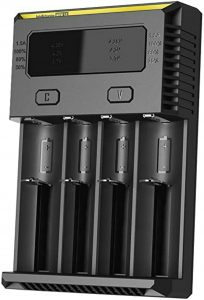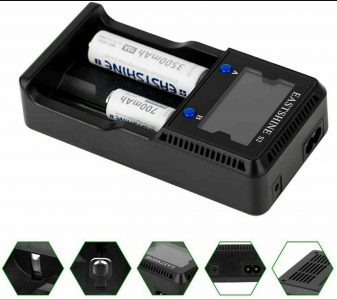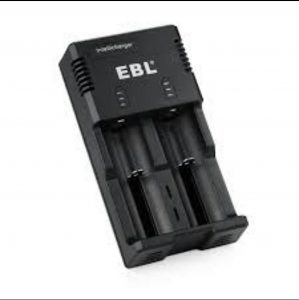The best 18650 battery chargers will help ensure that your electronic equipment is always charged and ready for use, which we are confident you will agree is a relentless battle.
Lithium-ion batteries have grown in popularity since their introduction by Sony in 1991. Because of their ability to deliver long-lasting power and cost-effectiveness, they have become the battery of choice in everyday items such as mobile phones and laptop computers.
The 18650 battery is one of the most common formats. This battery, which is widely being used in household appliances, is rechargeable. However, not all battery chargers are the same.
Most low-quality models on the market will degrade the battery, shorten its life, have inadequate charge, and be harmful in the worst-case situation.
This guide will walk you through the best chargers on the market, ensuring that your batteries are always ready and prepared for use—while also revealing some of their secrets. You will never have to “Battle the Power” again.
What is a 18650 Battery?
Down to the standard AA battery. The size is determined by the AA (AA, AAA, C, D, etc.). It’s rare. However, 14500 batteries are often referred to, a more reliable description of the size (14mm by 50mm—the final “0” means it’s cylindrical).
Similarly, 18650 batteries are named after their dimensions of 18mm by 65mm. They are also cylindrical, much like a standard battery. These batteries are used in two varieties: lithium and lithium-ion (or Li-ion or LIB). Lithium-ion batteries are the most important to us because they are rechargeable. In contrast to “standard” batteries, which are usually rated at 1.2 to 1.5 volts, lithium-ion batteries are typically 3.7 volts.
When is a Battery not a Battery, like when it’s a cell?
Doesn’t it seem like the most ironic joke in the world?
The problem is that, despite their differences, the terms cells and batteries have become almost synonymous.
You’re familiar with the shape of an AA battery: cylindrical, with a “button” on top and a flat bottom. The battery, on the other hand, is a cell. A battery is formed when two or more cells are grouped.
If you’ve ever dismantled a piece of electrical equipment, you might have discovered an enclosed grey box inside, which, if you have a strong “feel,” indicates that it comprises individual cells. The battery is included inside the gray box.
Nevertheless, in everyday language, the individual cells are typically referred to as batteries, which carries over to the term “battery-charger.” As a result, for this article, batteries and cells will be treated interchangeably.
These batteries are used in two varieties: lithium and lithium-ion (or Li-ion or LIB). Lithium-ion batteries are the most important to us because they are rechargeable. In contrast to “standard” batteries, which are usually rated at 1.2 to 1.5 volts, lithium-ion batteries are typically 3.7 volts.
The Best 18650 Battery Chargers in 2021 Are Reviewed Below
Quick Navigation
The following are our picks for the best 18650 battery chargers on the market. We have referred explicitly to the main features mentioned above, and any additional characteristics that we believe are relevant, where applicable.
1
Nitecore New i4 2016 Universal Smart Battery Charger
Nitecore, founded in 2007, is a global pioneer when it comes to the manufacturing of battery chargers, lamps and LED torches. Products from this manufacturer appear three times on the list of the best chargers, which attests to their consistency and reliability. The number on Nitecore models applies to the number of batteries that can be charged simultaneously so that the i4 can charge four.
It has an excellent voltage rating that ranges from 1.2 volts to 4.35 volts, allowing it to be used for a wide range of battery sizes. One of the most impressive features is the adjustable voltage. The charging voltage may be set for each particular battery bay independently of the others. This indicates that the charger can charge several types of batteries at the same time. This is a valuable feature if you have more than 18650 batteries in your devices.
The 1500mA output would cater to those who do not want to wait very long for their batteries to charge. Furthermore, if batteries other than the 18650s are used, the charger automatically senses the amperage needed. This charger has three helpful safety features that will give you peace of mind. To begin, the overcharge protector operates on a timer. The batteries in the impacted bays will stop charging if the charging time exceeds twenty hours.
Second, the Nitecore i4 has a reverse polarity shield, which means that if you put the battery in the charger the wrong way around, the charger would not work.
Third, the charger recognizes when a rechargeable or removable battery is present throughout the unit. It will not try to charge if the battery is disposable.
If the unexpected happens and there are some sparks or explosions, the Nitecore i4 is made of fire-resistant materials.
The visual interface displays information for each charging bay separately. Three green LEDs and one red LED show the charge’s success.
The use of a 12-volt (in-car) converter is a welcome addition to this charger. As a result, this product is perfect for those on the go that use batteries when traveling.
Key Features:
- New upgraded version
- Equipped with AC and 12V cords
- Capable of charging four batteries
- Most popular charger in the market
- Made from durable ABS
- Li-on compatibility
Specification:
- Size: 5.51 inches by 3.73 inches by 1.45 inches
- Weight: 7.12 ounces
- Input: AC 100 to 240 volts at 50/60 Hertz 0.25 Amps
- Output voltage: 1.48 volts to 4.35 volts
- Output current: 500mA-4, 500mA-2, 1500mA-1
- Battery compatibility: nickel-cadmium, , nickel-metal hydride, and lithium-ion
- Battery sizes: 26650
Pros
- Timed overcharge protector.
- It comes complete with a carrying case and a 12-volt adaptor.
- Individual bay voltage selection.
- Automatically detects amperage required.
- A wide range of batteries, voltages, and amperages catered for.
- Reverse polarity detector to prevent damage to batteries.
- Easy to read LED visual display.
Cons
- No quick charge ability—although a 1500mA output may be sufficient.
- Some users found the manual difficult to understand.
2
Eastshine S2 Universal Battery Charger
Eastshine, best known for its 18650 flashlights, has made a name for itself in the industry with the S2 18650 battery charger. The S2 cannot charge as many devices as the Nitecore i4 due to its two separate docking bays. What it loses in numbers, it makes up for in functionality.
As one would expect from Eastshine, protection is of the utmost importance. Overcharging is avoided by using a charge timer and a battery condition detector. The adapter can stop charging the battery if it has been charging for too long or ultimately charged.
Furthermore, this battery has a temperature monitor. If this value becomes too high, the charger will shut down, avoiding damage to you, the battery, or the charger.
If you enjoy technology, this machine will be of interest to you. The huge LCD is jam-packed with data. With a maximum pull of one volt, this is not the fastest charger in these reviews. Although it is nice to see that the appropriate voltage is automatically observed, there is no need to schedule it manually.
If you choose to use it with other batteries instead of a 18650, it can accept most typical sizes up to C level. The charger includes both a vehicle and a wall plug.
Key Features:
- It comes with fire-retardant material
- Universal charger
- Double bay speedy recharges
- Double slot smart chargers
- Automatic detect battery status
- Lifetime replacement
Specification:
- Size: 5.7 inches by 1.6 inches by 2.9 inches
- Weight: 6.2 ounces
- Input: AC 100 to 240 volts at 50/60 Hertz 0.25 Amps
- Output voltage: 1.48 volts to 4.2 volts
- Output current: 500mA-2, 1000mA-2
- Battery compatibility: nickel-metal hydride, lithium-ion and nickel-cadmium
- Battery sizes: 10340 through to 26650, AA, AAA, AAAA, C
Pros
- Virtual battery representation on the LCD screen.
- Two years free replacement warranty.
- Multi-information display—for those who love their detail.
- Temperature cut-out feature for safety.
- Independent charging and voltage in each of the two bays.
Cons
- Some users have noticed batteries lose contact quickly if the charger is disturbed.
- Cannot charge D-size batteries.
- One of the slower chargers
3
EBL 992 Battery Charger
EBL is best known for two things: batteries and battery chargers. Its extensive product line includes the simple but strong EBL 992. Getting down to basics is frequently the safest choice. Nothing beats freshly baked bread with lashings of butter, in our opinion. You can miss the fancy deli meats and cheeses; occasionally, convenience is what you need. The EBL 992 isn’t a sleek computer with many bells and whistles, but it does the job well. If you don’t need a charger with many alarms and whistles or are not comfortable with overly complex technology, this charger may be for you.
For a simple charger, safety is not compromised. Overvoltage, overcurrent, overcharge, overheat, and short circuit safety are also included. The only thing missing seems to be a reverse polarity sensor, so ensure you insert the batteries correctly.
If you travel often, the EBL 992 can be suitable for you. It’s one of the tiniest and lightest 18650 chargers we’ve ever seen (4.2 ounces). It can also be wired to a 12-volt DC output, but no cable is provided.
With two bays, this is ideal for the occasional customer. If you have a flashlight that you only use sometimes, this is the safest choice. I would recommend one with a larger battery capacity for heavier use.
This machine is outfitted with EBL’s patented “iQuick” charging technology. It claims that it can charge the batteries in half the time of most battery chargers. This is a valuable feature if you need some batteries right away. The charger automatically controls the voltage, but it can only accommodate up to 3.7 volts (standard for a 18650 battery). As a result, if you require a higher level, this will not suffice. Observing the charging stage is simple—there are no many screens to navigate on specific other chargers.
Three simple LED lights indicate the battery’s status. One appealing aspect is that they are very bright, with many users reporting that they can be seen from across the room. The EBL 992 can accommodate 18650 batteries, as well as sizes 10440 to 26650. This charger has many big vents to allow for quick airflow and keep it from overheating.
Key Features:
- Universal charger
- Smart LED display
- It turns green when fully charged
- Makes use of MCU control technology
- Provides current-voltage safety model
- High quality 18650 battery
- USB input
Specification:
- Battery compatibility: lithium-ion, nickel-metal hydride, and nickel-cadmium
- Input: AC 100 to 120 volts at 50/60 Hertz 0.25 Amps
- Output voltage: 1.48 volts to 3.7 volts
- Output current: 500mA-2
- Battery sizes: 10440 through to 26650, AA, AAA, AAAA and C
- Size: 5.7 inches by 2.9 inches by 1.4 inches
- Weight: 4.2 ounces
Pros
- Bright LED display showing battery charge stage.
- It charges very fast.
- Lightweight and easily transportable.
- Numerous safety features.
- Simple to use—ideal for technophobes.
Cons
- No reverse polarity detector.
- It’s pretty much very basic and may not be right for those that want more control
4
Nitecore i2 Intellicharge Universal Smart Battery Charger
This second Nitecore product on this best list offers the most attractive features of the i4, albeit in a more compact pack. The Nitecore i2 is ideal for the low-use user, as it has two individually charged battery bays.
Nitecore’s active current delivery (ACD) technology is used in the charger. When two batteries are charged simultaneously, and one stops before the other, all power is delivered to the remaining bay. As a result, charging is more effective and quicker. A timed overcharge cut-off, reverse polarity detector, and a novel IMR detector are among the safety features.
Most IMR 18650 vaporizer batteries contain lithium manganese oxide. As a result, they will discharge a strong current while staying cool. However, when charging a single cell, the i2 will produce up to 1000 mA, implying rapid charging—a valuable function for those who are restless. In contrast to the similar EBL 992, this compact charger can handle regular batteries up to D capacity and 10340 to 26650.
The three degrees of battery performance are shown by the transparent LED light (30 percent, 80 percent, and 100 percent). Although helpful, this may not be the best option for those looking for a more precise charge—the jump from 30% to 80% is significant.
Key Features:
- Recharges lithium
- Detects inserted battery
- LED indicates charging status
- Charges 2 batteries simultaneously
- Three colors LED displays
- High-quality battery
Specification:
- Battery compatibility: lithium-ion, nickel-metal hydride, and nickel-cadmium, IMR
- Output voltage: 1.48 volts to 4.35 volts
- Output current: 500mA-2/1000 mA1-1
- Battery sizes: 10340 through to 26650, AA, AAA, AAAA, C and D
- Size: 5.2 inches by 2.8 inches by 1.37 inches
- Weight: 4.4 ounces
- Input: AC 100 to 240 volts at 50/60 Hertz 0.25 Amps
Pros
- Fast charging.
- IMR 18650 battery detection.
- Despite being a small, two-battery charger, it can also cope with D-size.
- Automatically detects battery type and sets voltage.
Cons
- Lacks detailed charging status
5
Nitecore D4 4 slot smart battery
The excellent Nitecore D4 may be a smart option for users who enjoy data and intelligent displays. When you first see this charger, one feature sticks out from the rest: the LCD crystalline panel. First, it is enormous and transparent, with one of the largest screens on a charger you would ever see.
Second, the white on black high contrast display makes it easy to read the content. As a result, we believe it is an excellent option for those who do not have the highest visual skills and who want to display facts easily at a glance.
This may be a valuable function for people who want to be in charge and have access to all facts at all times. Another part of the show that I like is the “night-feature.” This allows you to switch off the screen while the batteries charge. If this piece is going to be used in the bedroom, this is a must-have.
The D4, like all Nitecore chargers, has an overcharge blocker and a reverse polarity detector. It should be noted, though, that this battery charger is designed for those who have smaller batteries in addition to their 18650s. While being larger than the Nitecore i2, it is unable to charge D batteries.
It is the only charger on this list that can handle LiFePO4 (lithium iron phosphate) batteries. If you have one of those, this is the charger for you. There is no easy charge feature, and it is not the quickest charger possible, with a maximum performance of 750mA.
Another cool feature is that this battery comes with eight Ni-MH rechargeable AA batteries. If you currently only have 18650 batteries, this addition can enable you to use rechargeables in other household items.
Key Features:
- Can charge four batteries at the same time
- Genuine Nicole
- It comes with a validation code on its package
- Compatible with several Li-ion rechargeable batter
- ies
- Long-lasting
Specification:
- Weight: 8.43 ounces
- Input: AC 100 to 240 volts at 50/60 Hertz Size: 5.6 inches by 3.9 inches by 1.4inches
- Output current: 375mA-4/750mA1-1
- Battery compatibility lithium-ion, nickel-metal hydride, and nickel-cadmium, IMR, and LiFePO4
- Battery sizes: 10340 through to 26650, AA, AAA, AAAA, and C
- 0.35 Amps
- Output voltage: 1.48 volts to 4.2 volts
Pros
- Complete with eight Ni-MH AA rechargeable batteries.
- Large vents and temperature monitor for cool-charging.
- Impressive LCD—easy to read and packed with information.
- Night feature to switch off-screen.
- Can charge LiFePO4 batteries.
Cons
- Long charging times.
- This least portable in this article—large and heavy.
Buying Guide Questions
What to Look for in a 18650 Battery Charger?
With too many different functions and safety features to choose from, finding the best battery charger can be difficult at first. Nonetheless, we hope to make things a lot easier.
You want the charger to do what you need it to do, but you don’t want to pay for features you’ll never need. Or those that are simply inapplicable to your situation. As a result, here is a quick guide to the features you can look for. Learn more here: (Best 18650 Flashlights in 2021)
Overcharge protection
Presently, the odds of a battery doing something drastic, such as collapsing and burning down your house, are slim. Increased safety measures inside the 18650 batteries themselves should prevent this from happening. On the other hand, overcharging a battery is never a brilliant idea, even though the safety mechanisms do not malfunction. Too much power will shorten the battery life, requiring you to spend your money on replacements. This can be avoided when using an overcharging protector feature.
Bay Numbers
This affects the number of 18650 batteries that can be charged simultaneously—how often depends on your personal use.
If you’re using the batteries for a vaporizer, a charger with a couple of bays can suffice—unless you vape like a chimney, of course. Nevertheless, if you are using several batteries simultaneously, such as in a power drill, a larger number of bays can be more tempting. Keep some extra batteries in a battery storage case to keep them secure and make them last longer.
Quick Charge Feature
A quick charging feature on the charger might be appealing, mainly if your vaporizer battery is dead and you need a nicotine hit right away. However, not charging the vape is potentially better. Don’t smoke or vape because it could kill you. If you’re the kind of person who is already prepared, with a constant supply of charged batteries in the drawer, you do not need this feature.
Visual Indicators and Displays
Unlike regular batteries, 18650 lithium-ion batteries do not need to be ultimately charged before use. If you need to use them right now, you can remove them from the battery and use them until they run out of juice. A visual interface will tell you how much power is left in the battery, helping you to determine if it is enough for use.
If you require a fully charged battery, a monitor will show how much longer you must wait for it to finish. However, if you are in dire need of it, keep in mind that “a watched kettle never boils.” Of course, that is not valid.
Check the condition of your batteries
It is essential to consider the present status of your batteries. We strongly advise you to look at what we believe to be the best battery tester available to the general public.
Battery Compatibility
You could have other different-sized rechargeables in your house, in addition to your 18650 batteries. If this is the case, it might be worth finding a charger that can accommodate all of these as well.
What is the best charger for 18650 batteries?
Purchasing high-quality 18650 batteries is essential, as any severe vaper knows. But that is just half of the battle… Charging those bad boys in a poorly constructed 18650 battery charger would significantly impact battery life!
Since 18650 batteries aren’t cheap, scrimping on the battery charger you use would almost certainly come back to haunt you in the long term!
A strong battery charger should have several safety features. It should also be able to charge several batteries simultaneously (independently) and provide you with as much detail about the status of the batteries as possible. In that case, we recommend the Nitecore i4 Universal Smart Battery Charger s the battery charger of choice. Learn more here: (Best 18650 Battery in 2021)
Do you need a special charger for 18650 batteries?
No, you don’t need a special charger for the 18650 battery. All you need is a good battery that is durable and has all the safety features. Going overboard would only set you back a few bucks. Nevertheless, don’t take our word for it. A good battery would cost more than a substandard battery.
How many amps should I charge my 18650 battery?
With a capacity of 2500 mAh, the 18650 is a typical cylindrical lithium cell. According to the datasheet, a 1250 mA constant current charge is recommended, followed by a 4.2 V regular voltage charge and charge termination when the current decreases to 50 mA.
How long does it take to charge a 3000mah 18650 battery?
Using a different charger, it takes about 4 hours to charge a 3000mah 18650 mod battery. It will most likely bring about three hours if you use a Micro USB adapter. However, even with a new charger, there could be some minor variations in charging times.
Where can I buy 18650 chargers?
Some of the best places to purchase the 18650 battery chargers are from reputable vendors that other customers have trusted. If you are buying online, then Amazon is probably your best bet.
How can I charge my 18650 without a charger?
Yes, a 18650 battery may be charged without a charger. Many kinds of batteries may be recharged using trickle charging. A trickle charge generates a prolonged electric current that the battery’s cells will absorb.
Can I use a 5V charger with a 3.7 V battery?
A 3.7V lithium battery, in general, requires an overcharge and over-discharge safety circuit board. Lithium batteries with safety circuit boards, on the other side, can be charged with 5V voltage (4.8V to 5.2V can be used). The charge cut-off voltage for 3.7V lithium batteries is 4.2V, and the discharge cut-off voltage is 3.0V.
How many years do 18650 batteries last?
The average lifespan of a typical 18650 battery is FAR shorter than 20 years. Nevertheless, if you don’t charge it much, it will not last more than ten years.
Why are 18650 batteries so popular?
Laptops and cordless tools are the most frequent users of 18650 cells. Laptops use low-amp cells with a medium-size which are available at the lowest possible price. The most useful 18650 cells for bikes come from cordless tools, which have the dual requirements of high amps and long-range.
Conclusion
Let’s get one thing straight: all of the chargers mentioned above are excellent products. The fact that they are tested and proven efficient chargers from reputable manufacturers is the most comforting. Compromising on low-cost, unreliable chargers will result in either dissatisfaction or an accident.
The Nitecore i4 is our favorite. It’s portable enough to be lightweight while still charging all of the standard battery sizes, including 18650 batteries. It’s a charger that delivers various safety features, rapid charging, and built-in intelligent systems. It also comes with a car charger for those on the go. So just because something is good for one person doesn’t mean it would be good for you.
The Eastshine S2 is a compact portable two-bay device with a lot of features. The EBL 992 is a simple computer for those who don’t want something too complicated. The Nitecore D4 is a must-have for those looking for information-packed displays.
Hopefully, this post has been of assistance, and you will no longer have to search to find a decent 18650 battery charger.






